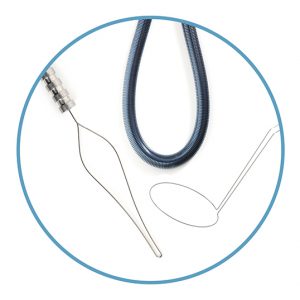As the global rate of cardiovascular disease continues to rise, manufacturers are exploring alternative materials to support the development of their life-saving medical devices. One important breakthrough has been the emergence of nickel-titanium (nitinol, NiTi), which was first used in medical devices in the late 1980s. Today, the metal alloy is giving stainless steel a run for its money in certain applications, particularly in catheter reinforcement coils, guidewire cores (core wires), stents, and orthopedic pins and wires.
Nitinol offers numerous advantages for medical devices, including increased strength and unique shape memory abilities. But manufacturers must either overcome significant challenges or work with a seasoned company that has already mastered the nitinol grinding and shape-setting processes.
Nitinol Properties
In common with all materials that are eligible for medical device manufacturing, nitinol is biocompatible and corrosion-resistant. Beyond these important prerequisites, NiTi has become widely known for its fatigue strength and ability to take a high level of strain before plastic deformation. Wire made from nitinol is often dubbed ‘kink-resistant’, making it particularly suitable for catheter and guidewire applications, where the device is required to traverse tight bends, intrinsic to blood vessel anatomies.
Nitinol’s other unique property is its ability to remember the shape it was set in and return to this form under specific temperature conditions. This can enable more minimally invasive delivery of stents, which collapse under their transformation temperature (facilitating insertion via intravenous catheter) and then return to their original shape as they reach body temperature.
For more on this read: NITINOL – The Superelastic Alloy
A Hard Grind
Medical device companies eager to come up with new innovations based on nitinol’s unique properties are often met with challenges while working with the material as it is difficult to machine by milling or turning.
Excellent results can be achieved through abrasive techniques such as centreless grinding, but manufacturers should expect a high degree of tool wear due to nitinol’s titanium oxide surface, which makes the material extremely tough and abrasive. Carbide grinding wheels made from high-grade carbon steel are considered best practice for mitigating these issues.
Temperature management is another important consideration. Heat generated through friction can be significant during grinding as some portion of this warmth is transferred to the workpiece, and because nitinol reacts to temperature changes its shape can alter. Coolant is therefore required to develop a heat-free system that prevents the deformation of the workpiece during manufacturing.
Logistical Challenges
The nitinol shape-setting process can present its own logistical challenges, as the procedure demands additional space requirements from work-in-process (WIP) storage and equipment, says Jim Boldig, director of sales and engineering at Custom Wire Technologies (CWT).
“CWT is always investigating ways to manage space and time to be as efficient as possible. We have recently invested in vertical storage for WIP and purchased new equipment that is effectively two machines in one,” explains Boldig. CWT adapts the wire’s mechanical and thermal properties for specific applications through careful management of the heat-treatment process.
CWT’s first experience with nitinol was in 2010 when it helped an original equipment manufacturer to develop a suture threader in which the material returned to the threader’s pre-set shape after passing through the small hole in the suture. Today, the company sets a high number of nitinol coils for catheter-reinforcement purposes, with the transformation temperatures set to customers’ specific needs.
CWT has also perfected its nitinol grinding operations for core wires, mandrels, and orthopedic wires; a process that only a few medical companies are able or willing to do. In addition, thanks to vertical integration, CWT can take a ground piece and shape-set the material into a more complex form.
Growing Nitinol Demand
As more medical device companies devise innovative ways to make use of the material’s properties, nitinol projects are increasing for ISO 13485-compliant contract manufacturers such as CWT, which makes an array of high-quality shapes through precision grinding and shape setting.
“We have open orders with our raw material supplier for quantities of more than 18 million linear feet of a single diameter. One of our product lines is using roughly 200,000 ft per week,” says Boldig. “We have come to embrace the material. It works extremely well for core-wire grinding and reinforcement coils for catheters.”
After 13 years spent working with nitinol, CWT has a solid understanding of what works and what doesn’t, as well as how to cope with the material’s many challenges to deliver high-quality components for its medical customers.
LET’S CONNECT!
To learn more about how Custom Wire technologies can serve you and your business, be sure to reach out! We look forward to hearing from you and learning how we can be of service.



